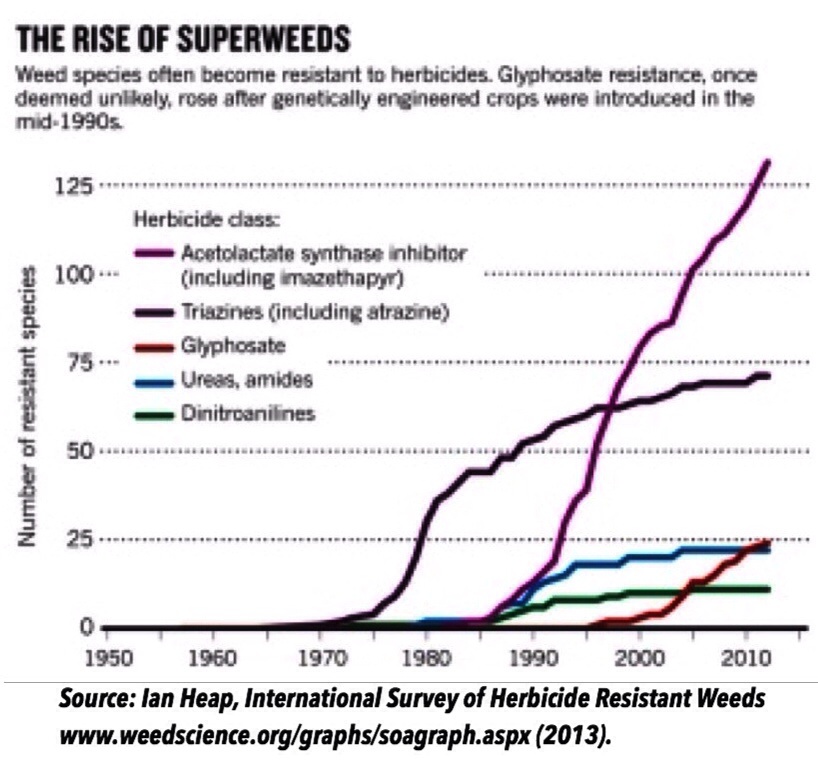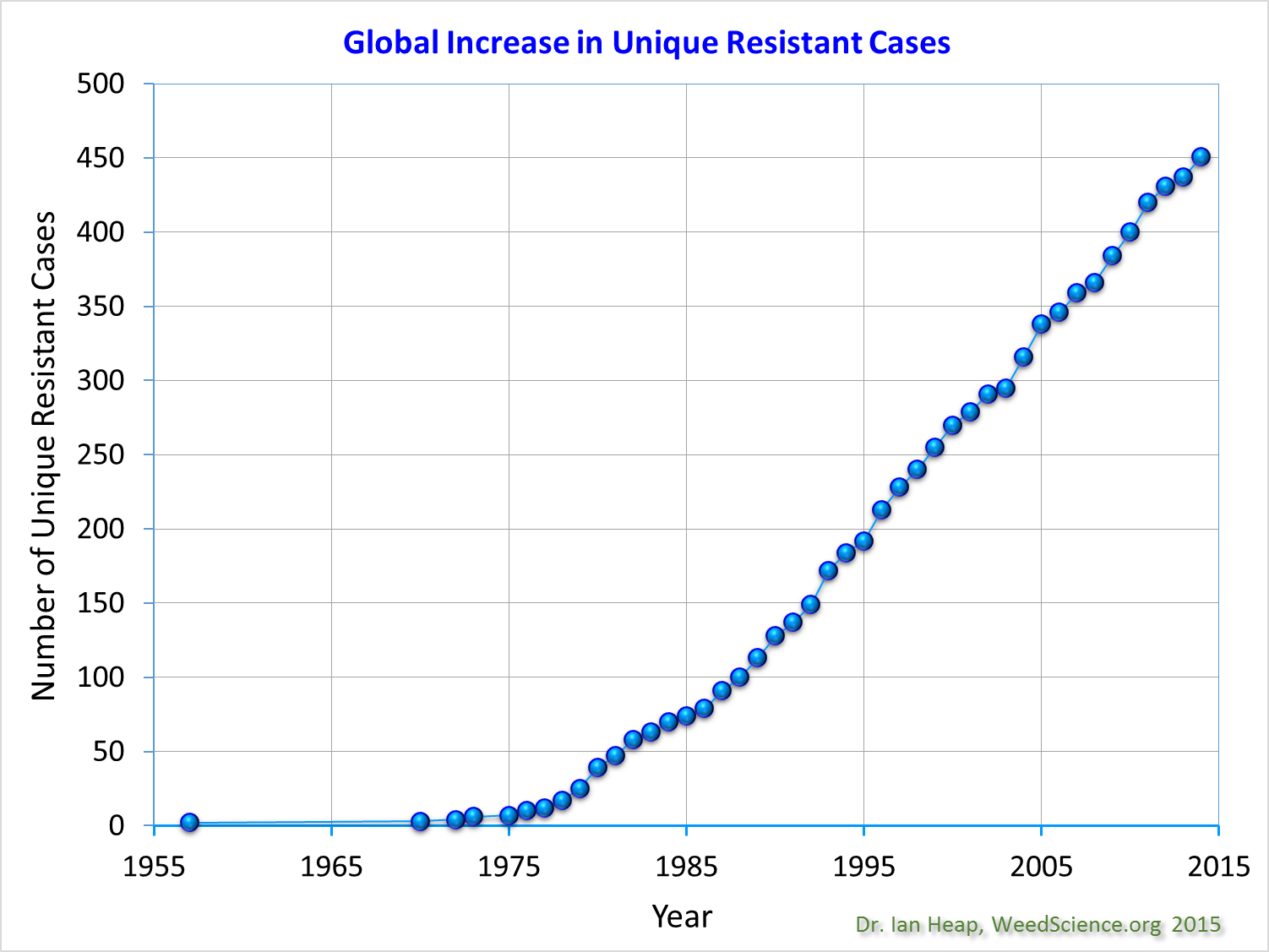One of the more common criticisms leveled against Genetically Engineered plants, particularly Herbicide-Resistant (HR) strains, is that they are purported to lead to what critics refer to as “Superweeds.” The term superweeds is not a scientific term, and can be very misleading to people not familiar with the science. What is really meant by the term is the event in which local weeds become resistant to a particular mode of action undertaken by the farmer for the purpose of weed control. For instance, local weeds might evolve a resistance to a particular herbicide is it’s used often in the areas in which they grow. There’s nothing “super” about the alleged superweeds other than the fact that they’ve become resistant to one particular method.
That said, there are legitimate concerns over the evolution of weeds developing resistance to herbicides (such as glyphosate), or for that matter insects building resistance to a particular insecticide (such as Bt), but that’s an issue that affects all methods of pest control. It happens with all herbicides and insecticides, whether they’re organic, synthetic, or naturally produced by the plants, and can occur either via evolution with respect to certain local selection pressures (such as a high usage rate by farmers of a particular herbicide or insecticide), or via horizontal gene transfer. However, anti-GMO activists frequently try to frame the issue of resistant weeds as a uniquely GMO-related problem, (particularly in the case of glyphosate), which shows either ignorance and/or intellectual dishonesty of the anti-GMO movement.
Natasha Gilbert, the author of the following Nature article explains:
“But herbicide resistance is a problem for farmers regardless of whether they plant GM crops. Some 64 weed species are resistant to the herbicide atrazine, for example, and no crops have been genetically modified to withstand it.”
As a matter of fact, even tilling weeds by hand can lead to resistant weeds. Indeed, one of the benefits of herbicide resistant crops is it makes it much easier to employ no-till farming, the benefits of which include a reduction in farming-related greenhouse gas emissions and and improved environmental impact quotient, as demonstrated here and here.
One particularly prominent example of herbicide-resistance arising via a combination of selective breeding and mutagenesis is the Clearfield line of plants developed by the BASF company. The Clearfield brand plants are resistant to a class of herbicides called acetolactate synthase inhibitors (or simply ALS inhibitors). ALS is an enzyme involved in the biosynthesis of the branched chain amino acids (leucine, isoleucine and valine) in many plants, fungi, algae, bacteria and yeasts. Resistance to ALS inhibitors has independently arisen multiple times in plants, and has done so by more than one mechanism.
In the case of BASF’s Clearfield line, my understanding of it is that they looked for instances in which a relevant ALS gene mutation had occurred naturally in wild plants sexually-compatible with the crops in which they wished to imbue the trait, and then bred the resistance to ALS inhibitors into their target plants over the course of a few generations, and crossed out any undesired phenotypes which came along for the ride. In cases for which no plants sexually-compatible with the target plant could be found with the desired ALS gene mutation, it was induced via mutagenesis. Mutagenesis is a plant breeding method whereby radiation and/or chemicals are used to speed up the rate of random genetic mutations in hopes that one of them will yield a desirable phenotype, in which case the plant with the desired mutation is kept and selectively bred. This was how ALS resistance was induced in wheat. Chris Barbey, a PhD student in plant molecular genetics and cell biology explains more about the aforementioned process here.
*As a side note, it’s worth keeping in mind that plants created in this manner are extremely common (here’s a registry of them), and are required to undergo no safety or allergy testing whatsoever, despite the fact that the changes induced are random, completely untracked, and the number of genes affected by the process is FAR greater than the number of genes typically altered in the case of modern molecular genetic engineering techniques. In the US, they are even permitted in organic farming (though the same is not true in most European countries).
Ironically, while anti-GMO activists have been foretelling of the allegedly impending doom of glyphosate-resistant weeds arising from the use of glyphosate resistant GE crops, the number of resistant weeds arising in response to herbicides commonly employed on non-GE crops has been far greater (particularly in the case of the aforementioned ALS inhibitors, as well as triazines) as you can see below.

c/o Weedscience.org (click for the most updated version).
To add insult to injury, Chipotle, the popular restaurant chain which famously announced in 2015 that they’d be going completely GMO-free, used the avoidance of herbicide-resistant weeds as one of their primary justifications for rejecting GE foods. This was an additional irony due to the fact that now the foods they use almost certain to have been grown using pesticides FAR more likely to select for herbicide resistant weeds than the ones they replaced by rejecting GE foods. Their change over appears to have been based on a desire to capitalize on unfounded public trepidation towards genetically engineered foods, and is unlikely to have any positive effect with respect to toxicity, food safety, or the safety of pesticide applicators. Weed scientist, Andrew Kniss explains this development in more detail here.
Moreover, although weed resistance has slightly increased, the RATE at which herbicide resistant weeds have been developing since the rise in glyphosate resistant GMO crops has not increased. In fact, after the introduction of herbicide resistant GE crops, the number of new herbicide resistant weeds actually DECREASED to 11.4 documented cases per year. Practically speaking, the difference in the slopes (which represent the rate at which herbicide resistance develops) of the regression lines between the two time periods are probably not meaningful, but the point is that, based on the best data available, we can be quite certain that adoption of GE crops has NOT increased the rate at which resistant weeds have developed relative to other uses of herbicide.
The following graph presents the chronological increase in unique cases of herbicide resistant weeds. Glyphosate-Resistant GE crops were introduced to the commercial market in 1996, at which time they swiftly became popular. Notice how there is no increase in the steepness of the slope of the graph following their introduction.

From Weedscience.org
Weed scientist, Andrew Kniss goes into greater depth on that here, as does this article here by my friend, Marc Brazeau, creator of Food and Farm Discussion Lab.
Now, it’s all fine and good to highlight the inconsistent logic and lack of adequate analysis of the facts on part of the critics of GE foods, but it seems rather unsatisfactory to merely point out that their criticism is an equally real problem for all crops, but a simple “tu quoque” only rebuts the unique application of the criticism to GE crops, but doesn’t really prescribe any viable means of dealing with the problem.
So what’s the solution?
Well, one crucial component appears to be increasing diversity of weed management protocols. Although there’s a critical caveat with the following recommendations based on recent research (more on that in a moment), according to weed science professors at the University of Wisconsin and Iowa State University, the following practices should help:
“These weed management practices avoid the continuous and exclusive use of glyphosate and lessen the potential for developing glyphosate-resistant weeds:
- Rotate between Roundup Ready® and conventional crops or crops with other types of herbicide resistance.
- Use Roundup Ready® crops and glyphosate in your crop rotation where they have the greatest economic and management value.
- Rotate glyphosate with herbicides that have different modes of action.
- Apply a residual herbicide before glyphosate or tank mix another herbicide with glyphosate.
- Avoid making more than two glyphosate applications to a field over a two-year period.
- If glyphosate is used as a burndown treatment and in-crop in the same year, tank mix the glyphosate applied in the burndown treatment with an herbicide that has a different mode of action. The in-crop glyphosate application should still be rotated with other herbicides in other years.
- Use cultivation and other mechanical weed management practices.
- In addition, growers should apply glyphosate at labeled rates and at the correct stage of weed and crop growth to reduce the risk of poor control. Also, scout fields regularly, identify the weeds present, and record their locations on maps to allow a quick response to changes in weed populations.”
Here’s the caveat: although it was previously more common to believe that rotating herbicides would be a good strategy to slow the development of herbicide resistant weeds, there is some compelling new research which suggests otherwise. Instead, the superior strategy may be to use a second herbicide with a different mechanism of action concurrently rather than alternating between them. The data actually suggests that rotating them may exacerbate the onset of herbicide resistance.
This may seem counter-intuitive at first, but consider that mutations conferring resistance to a particular herbicidal mechanism of action are relatively rate as it is. If some weeds develop such resistance to one herbicide, then they have a chance to proliferate that trait throughout their population. Later, when the farmer rotates to another herbicide, there’s a chance that a few of the weeds in the local population (some of which already have evolved resistance to the first herbicide) will end up with an additional mutation rendering them resistant to the second herbicide.
Alternatively, if two herbicides with different mechanisms of action are used at once, the likelihood is far less that any weeds in the population will suddenly have not one, but two new mutations that just happen to be the correct mutations to confer resistance to both mechanisms of action simultaneously. If they develop the mutation to resist one or the other, but not both, then the weed just dies. It can’t pass on that trait. This is a bit of an oversimplification, but that’s the basic idea. Importantly, it’s consistent with the data. For a more in-depth explanation, I defer once again to weed scientist, Andrew Kniss’s articles here and here.
So, in conclusion, the issue of resistant weeds is a legitimate one, but since it is neither unique to GE crops, nor any less problematic with non-GE crops, it is not a legitimate criticism of GE foods. There are practices capable of helping farmers manage the problem, but discarding GE technology is not one of them.
BOOM!



1 Comment
Mandatory GMO Labeling Opposition: Not just for Shape-Shifting MonSatan Cyborg Super-Shills from the future – The Credible Hulk · May 16, 2016 at 5:14 am
[…] also already addressed other common specious pro-labeling arguments such as patents, “superweeds,” pesticide use (GE crops have actually helped reduce total pesticide use, and facilitate […]
Comments are closed.